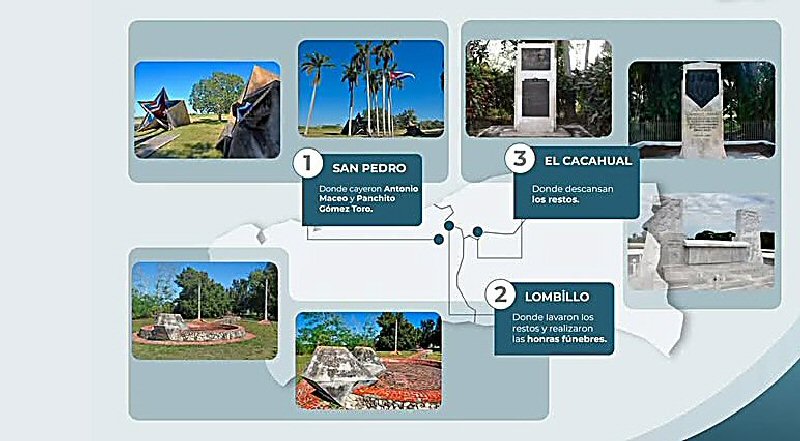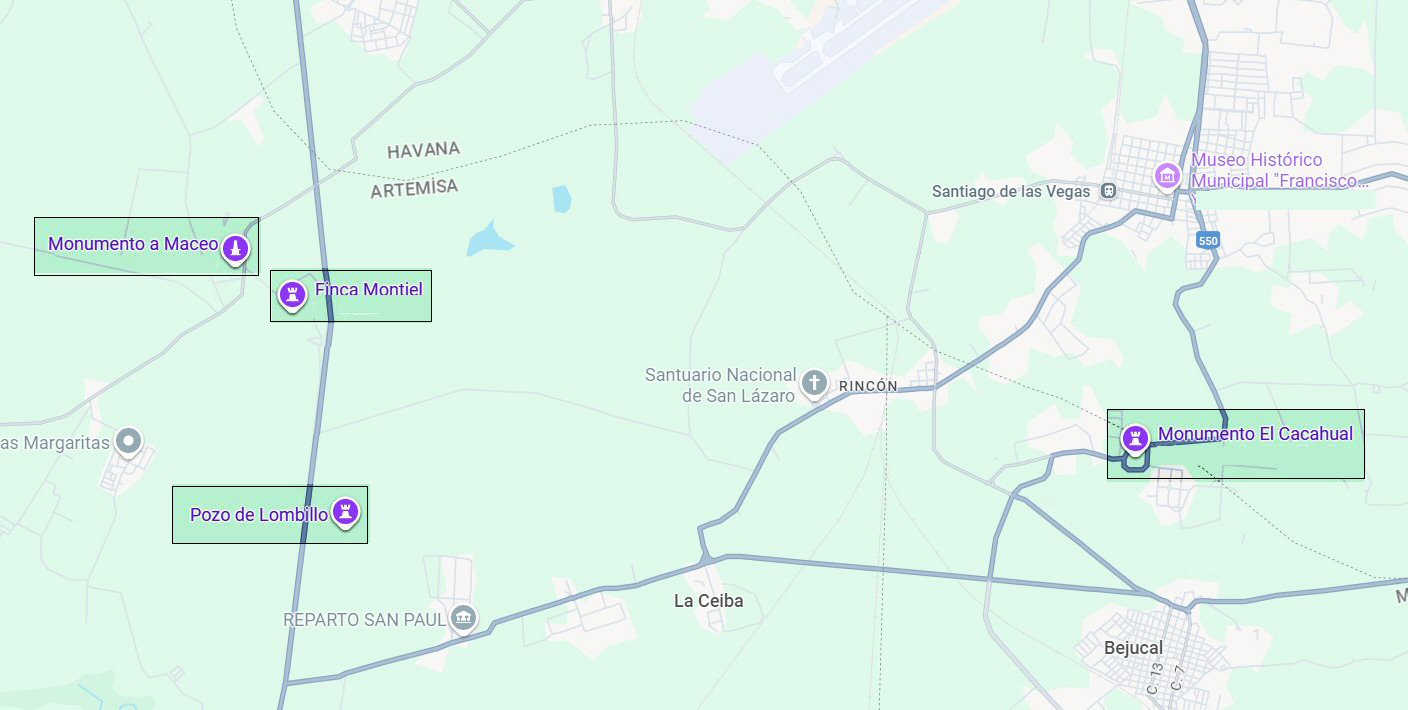
MONTIEL ESTATE
The Montiel estate is a place where Antonio Maceo established his headquarters before his death in the Bobadilla quarter on Monday, December 7, 1896. It is adjacent to the Complejo Monumentario de San Pedro de Punta.
It was a suitable place for a temporary camp. Previously, there was a house, half-destroyed by fire, a well that provided water, and a small grove of mamey and avocado trees.
Years later, in 1929, the mayor and a group of veterans highlighted the site's significance. On September 7, 1952, a wooden plaque was placed on the palm tree to which Maceo's hammock had been tied: "General Antonio Maceo was camping here on December 7, 1896."
In 1997, a new project was launched to understand the camp's operations through landscaping and restoration of dilapidated structures. To provide a more realistic view of the site, the grove was recreated using species from the period. The spot where Maceo hung his hammock was symbolically marked. A pergola made of galvanized pipes was built on the same ground as the ruins and covered with picuala, a dense and fragrant vine.
A traditional courtyard was created between the ruins and the pergola. The plaque at the entrance of the courtyard reads "Route of the bodies of General Antonio Maceo Grajales and Captain Francisco Gómez Toro, who fell on 7/12/1896". A triangular stone container covered with gravel was also built, allowing visitors to move from the pergola to the mamey and palm tree, where Maceo hung his hammock.
POZO DE LOMBILLO (Well of Lombillo)
On the left side of the road from San Pedro to San Antonio de los Baños, there is an sign indicating the entrance to the Pozo de Lombillo. This is that place where during the afternoon of December 7, 1896, the funeral services were held for Lieutenant General Antonio Maceo y Grajales and his aide, Captain Francisco Gómez Toro. The site is an important annex to the Antonio Maceo Monumental Complex.
There was a building with a hipped thatched roof on wooden pillars, no walls, and a primitive floor, as well as a well from which water was drawn using a waterwheel. After the bodies of Maceo and Toro were brought here, they were laid out in this house. They were washed clean with water drawn from that well.
The Mambis kept a vigil over the bodies throughout the night. Four crude candles, made of yellow wax and canvas wicks, were lit around the bodies, and efforts were made to keep them from extinguishing throughout the night.
The officers and soldiers walked in front of the bodies without funeral pomp or luxurious wreaths, touching the lifeless bodies with devotion. Some wept, others kissed the dead.
In the early hours of the morning before the dawn, the bodies were taken by Colonel Juan Delgado to Cacahual.
In 1945, a women's club called Mariana Grajales unveiled a plaque at the site of the tragic events to bequeath to future generations the place where the remains of the Maceo and Toro were washed, laid to rest, and held in state. The plaque is with the following description: "At this spot, the bodies of Major General Antonio Maceo Grajales and Captain Francisco Gómez Toro were laid to rest by Cuban troops. They died heroically in San Pedro on December 7, 1896. The Havana Province Commission of Historic Sites and the Mariana Grajales Foundation are preserving this site for posterity on the occasion of the centenary of General Maceo's birth on June 14, 1945."
There is a canal at the site that extends to a monument representing the bodies of the two mambises, which appear artistically reflected as two inseparable rocks. The current monument was built in 1997.
The Montiel estate is a place where Antonio Maceo established his headquarters before his death in the Bobadilla quarter on Monday, December 7, 1896. It is adjacent to the Complejo Monumentario de San Pedro de Punta.
It was a suitable place for a temporary camp. Previously, there was a house, half-destroyed by fire, a well that provided water, and a small grove of mamey and avocado trees.
Years later, in 1929, the mayor and a group of veterans highlighted the site's significance. On September 7, 1952, a wooden plaque was placed on the palm tree to which Maceo's hammock had been tied: "General Antonio Maceo was camping here on December 7, 1896."
In 1997, a new project was launched to understand the camp's operations through landscaping and restoration of dilapidated structures. To provide a more realistic view of the site, the grove was recreated using species from the period. The spot where Maceo hung his hammock was symbolically marked. A pergola made of galvanized pipes was built on the same ground as the ruins and covered with picuala, a dense and fragrant vine.
A traditional courtyard was created between the ruins and the pergola. The plaque at the entrance of the courtyard reads "Route of the bodies of General Antonio Maceo Grajales and Captain Francisco Gómez Toro, who fell on 7/12/1896". A triangular stone container covered with gravel was also built, allowing visitors to move from the pergola to the mamey and palm tree, where Maceo hung his hammock.
POZO DE LOMBILLO (Well of Lombillo)
On the left side of the road from San Pedro to San Antonio de los Baños, there is an sign indicating the entrance to the Pozo de Lombillo. This is that place where during the afternoon of December 7, 1896, the funeral services were held for Lieutenant General Antonio Maceo y Grajales and his aide, Captain Francisco Gómez Toro. The site is an important annex to the Antonio Maceo Monumental Complex.
There was a building with a hipped thatched roof on wooden pillars, no walls, and a primitive floor, as well as a well from which water was drawn using a waterwheel. After the bodies of Maceo and Toro were brought here, they were laid out in this house. They were washed clean with water drawn from that well.
The Mambis kept a vigil over the bodies throughout the night. Four crude candles, made of yellow wax and canvas wicks, were lit around the bodies, and efforts were made to keep them from extinguishing throughout the night.
The officers and soldiers walked in front of the bodies without funeral pomp or luxurious wreaths, touching the lifeless bodies with devotion. Some wept, others kissed the dead.
In the early hours of the morning before the dawn, the bodies were taken by Colonel Juan Delgado to Cacahual.
In 1945, a women's club called Mariana Grajales unveiled a plaque at the site of the tragic events to bequeath to future generations the place where the remains of the Maceo and Toro were washed, laid to rest, and held in state. The plaque is with the following description: "At this spot, the bodies of Major General Antonio Maceo Grajales and Captain Francisco Gómez Toro were laid to rest by Cuban troops. They died heroically in San Pedro on December 7, 1896. The Havana Province Commission of Historic Sites and the Mariana Grajales Foundation are preserving this site for posterity on the occasion of the centenary of General Maceo's birth on June 14, 1945."
There is a canal at the site that extends to a monument representing the bodies of the two mambises, which appear artistically reflected as two inseparable rocks. The current monument was built in 1997.
